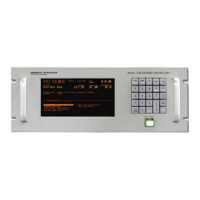Operation
TABLE 5-5 STEPTRACK PARAMETERS
PARAMETER DEFAULT DESCRIPTION
Maximum no. of
cycles
5
Limits the number of AZ and EL cycles (attempts) that the steptrack
algorithm makes in finding the pea
k signal. Nominal value is 5, but the
value should be decreased for a very fast target as steptrack assumes
target is fixed for duration of steptrack operations.
Cycle to start rate
estimates
3
Sets the cycle at which rate estimates will be made during st
eptrack
operations. The rate estimates are only made when no OPT solution
exists for the target being tracked. If an OPT solution is available, the
rates used by steptrack are obtained from OPT. The nominal value is 3,
but should be decreased to 2 for a
very fast target. For a stationary
target, the value should be set to 5.
Peaking correction
limit (%BW)
30
Sets the maximum beam radial distance steptrack will adjust the antenna
pointing in one cycle. The value is given in percent of -
Nominal value is 30% -- this can be lowered to 10% to limit the steptrack
working area but will inhibit the ability of steptrack to peak on a highly
inclined satellite.
Weight adjustment
value
1.00
The steptrack algorithm combines data together by a weigh
ting system
which is determined automatically. This parameter can be used to
magnify the internal weighting under special situations. The nominal
value is 1.0 and should not be changed unless directed by
Dynamics personnel. Increasing this value decreases the responsiveness
of steptrack.
Low tracking
signal level [dB]
-10.00 dB
Defines the lowest signal level that steptrack can work with to perform
its operations. If the signal falls below this level while steptracking, the
ACU will display a Low tracking signal level message and wait until the
signal rises above this level before attempting another steptrack cycle.
NOTE: Setting this value too close to 0 dB will interfere with proper
steptrack operation.
Signal threshold
[dB]
15.00 dB
This p
arameter is used in both standalone steptrack and OPT to initiate
steptrack operation if the signal drops by this many dB between steptrack
operations. In a noisy environment, a small value will cause excessive
steptrack operations. Setting this value la
rger than the "Low tracking
signal level" will effectively disable this parameter. The default value,
15.00 dB, is less than the default "Low tracking signal level, and for most
applications (and all OPT tracking), it should remain so. While the ACU is
waiting for the cycle time to expire (to begin a new steptrack cycle), if
the signal falls by this many dB below the most recently acquired peak, it
will do a steptrack cycle immediately. If the signal threshold is set below
the Low tracking signal level [d
B], it will only do steptrack cycles at
intervals given by Cycle time.
Axis to peak first Elevation
Allows selection of which axis is peaked first during steptrack cycle.
Normally, the axis for which the satellite has the greatest apparent
motion is peaked first. Select AZ only if the required motion for following
the satellite is more AZ than EL. Otherwise, set this parameter to EL.
Unless the spacecraft's inclination is high (greater than approximately 5
degrees), this parameter has no noticeable effe
ct, and may be left at the
default.
# of samples 10
This sets the number of signal readings taken at each position during
steptrack. The default is 10, which is good for virtually all applications.
The value should be between 3 and 70.
5-16

